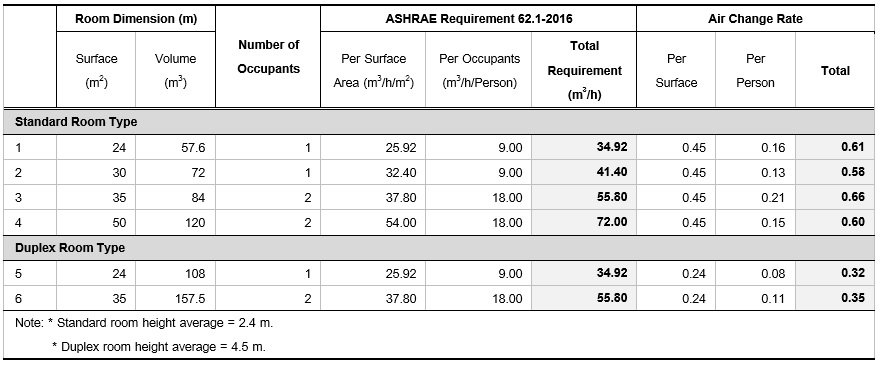STUDY OF RESIDENTS’ BEHAVIOR FOR CONCEPTUAL DESIGN OF ROOM VENTILATION OF CONDOMINIUMS IN BANGKOK
Main Article Content
Abstract
Nowadays, people in Bangkok prefer to live in a condominium. Climate change and PM 2.5 affect the behavior of residents of buildings. Closing doors and windows to prevent dust and directly turning on the air conditioner to reduce accumulated heat and create comfortable conditions are usual practices that result in poor indoor air quality due to poor ventilation.
This paper aims to identify appropriate ventilation concepts to improve indoor air quality for the residents of condominiums. To this end, the research studies the factors affecting residents’ behavior in condominiums in Bangkok. Quantitative data collected from 400 samples of people were analyzed statistically by considering the goodness of fit of the data, the relationships between factors, the independence test, and principles of ventilation were studied and conducted to identify the proper room ventilation rate. It was found that urban heat island and outdoor air quality are the main factors that affect the behavior of indoor living. The proposed concept design of ventilation system at an appropriate ventilation rate can reduce the accumulation of heat and humidity in the room resulting in a state of thermal comfort, the reduction of energy consumption of the air conditioner when operated. Consequently, it will result in improving air quality to be within the standard (Indoor Air Quality: IAQ) and to reduce the risk of residents' health problems.
Article Details

This work is licensed under a Creative Commons Attribution-NonCommercial-NoDerivatives 4.0 International License.
เนื้อหาและข่อมูลในบทความที่ลงตีพิมพ์ในวารสารวิชาการ เทคโนโลยี พลังงาน และสิ่งแวดล้อม บัณฑิตวิทยาลัย วิทยาลัยเทคโนโลยีสยาม ถือเป็นข้อคิดเห็นและความรับผิดชอบของผู้เขียนบทความโดยตรง ซึ่งกองบรรณาธิการวารสารไม่จำเป็นต้องเห็นด้วย หรือว่าร่วมรับผิดชอบใด ๆ
บทความ ข้อมูล เนื้อหา รูปภาพ ฯลฯ ที่ได้รับการตีพิมพ์ในวารสารวิชาการ เทคโนโลยี พลังงาน และสิ่งแวดล้อม บัณฑิตวิทยาลัย วิทยาลัยเทคโนโลยีสยาม ถือเป็นลิขสิทธิ์ของวารสารวิชาการ เทคโนโลยี พลังงาน และสิ่งแวดล้อม บัณฑิตวิทยาลัย วิทยาลัยเทคโนโลยีสยาม หากบุคคล หรือหน่วยงานใดต้องการนำทั้งหมด หรือส่วนหนึ่งส่วนใดไปเผยแพร่ต่อ หรือเพื่อกระทำการใด ๆ จะต้องได้รับอนุญาต เป็นลายลักษณ์อักษรจากวารสารวิชาการ เทคโนโลยี พลังงาน และสิ่งแวดล้อม บัณฑิตวิทยาลัย วิทยาลัยเทคโนโลยีสยาม เท่านั้น
References
สำนักข่าว efinancethai. (วันที่สืบค้น 21 ธันวาคม 2565). เจาะ 4 สาเหตุ ทำไมคนส่วนใหญ่ถึงเลือกอยู่คอนโดมากกว่าบ้าน, [ระบบออนไลน์] แหล่งที่มา: https://www.efinancethai.com/advertorial/
J. Khedari, A. Sangprajak, J. Hirunlabh, “Thailand climatic zones”, Renewable Energy, Vol. 25, (2002), pp. 267-280
Rathphum Pakarnseree, Kasem Chunkao, Surat Bualert, “Physical characteristics of Bangkok and its urban heat island phenomenon”, Building and Environment, Vol. 143, (2018), pp. 561-569
climatekids.nasa. (14 December 2022). What Is an Urban Heat Island, [Online] Available:
https://climatekids.nasa.gov/heat-islands/
จอร์จ เคดารี, ธนา อนันต์อาชา. “ประสิทธิภาพของตู้เสื้อผ้าบิวท์อินระบายอากาศ.” การประชุมทางวิชาการของมหาวิทยาลัยเกษตรศาสตร์ ครั้งที่ 60. 21-23 กุมภาพันธ์ 2565. มหาวิทยาลัยเกษตรศาสตร์ บางเขน: 181-188. 2565.
BLTBangkok. (วันที่สืบค้น 14 ธันวาคม 2565). สถิติการพักผ่อนของคนกรุงเทพฯ, [ระบบออนไลน์]
แหล่งที่มา: https://www.bltbangkok.com/poll/
อรพรรณ โพชนุกูล. (วันที่สืบค้น 11 ธันวาคม 2565). “SICK BUILDING SYNDROME” ภัยคนเมือง 2020, [ระบบออนไลน์] แหล่งที่มา: https://tu.ac.th/thammasat-sick-building-syndrome-2020
Yamane, Taro. Statistics: An Introductory Analysis, 2nd Edition, New York, Harper & Row, 1967
American Society of Heating, Refrigerating and Air-Conditioning Engineers (ASHRAE), Standard 62.1-2016 Ventilation for Acceptable Indoor Air Quality, Atlanta, 2016
Vorakamol Boonyayothin et al, “Ventilation control approach for acceptable indoor air quality and enhancing energy saving in Thailand”, International Journal of Ventilation, Vol. 9, No. 4, (2011), pp. 315-326


